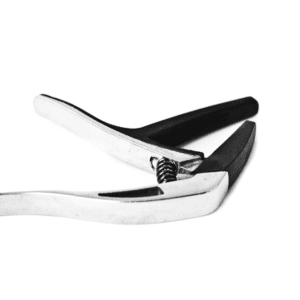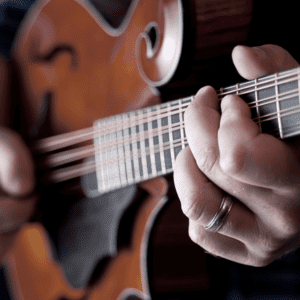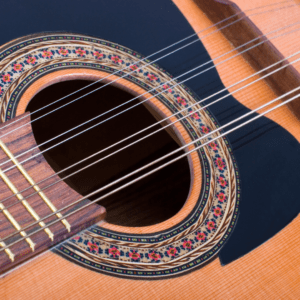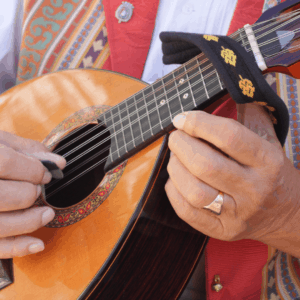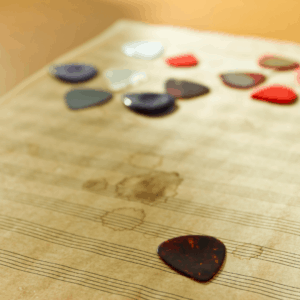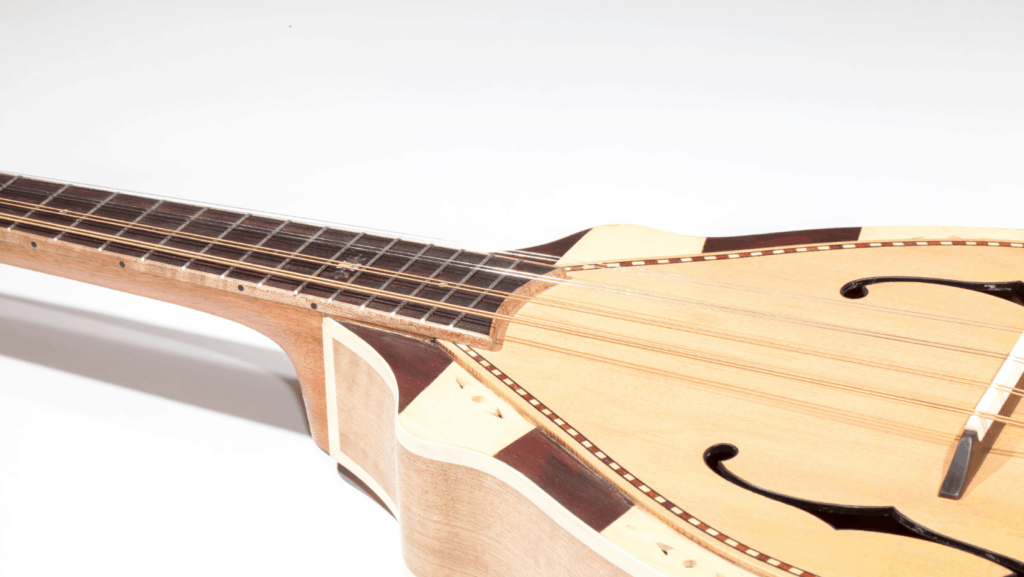
The mandolin is a string instrument in the lute family that has a history stretching back a few centuries. It’s popular nowadays with various kinds of folk music as well as in bluegrass and country. It’s an instrument that’s usually plucked with a plectrum to produce its sound.
The sound tone and feel of the mandolin are dictated by the quality of the tonewoods and the construction, like on any other string instrument. But, that being said, a string instrument is also dependent on, well, the strings.
There are many different types of strings out there for you to choose from. All can affect the type of sound you want to achieve and the way they respond to your touch. Different types of strings can also be used for different playing situations. It’s not easy to suggest the best mandolin strings. This can differ from instrument to instrument, as well as between musicians and playing styles.
Let’s look at some of the most popular mandolin strings on the market.
| 1. Best High-Quality Mandolin Strings – Elixir Mandolin Strings with NANOWEB Coating Corrosion-resistant strings with a bright and responsive tone. | Buy on Amazon | |
| | 2. Most Comfortable Mandolin Strings – D’Addario EFW74 Phosphor and bronze flat wound strings that offer an appealing balance between quality and price. | Buy on Amazon |
| | 3. Best Light Gauge Beginner Mandolin Strings – Martin Mandolin 80/20 – Bronze Wound Light and responsive strings that are both durable and splendid value. | Buy on Amazon |
| | 4. Best Medium Gauge Mandolin Strings – Ernie Ball Earthwood Mandolin Medium Strings Beautiful-looking strings that are kind to your fingers and easy to play. They have a looped end and are suitable for beginners. | Buy on Amazon |
| | 5. Best Flatwound Mandolin Strings – Thomastik-Infeld 154 Mandolin Strings Solid steel core strings with a tin plating. Responsive and easy to play with good intonation on lows and highs. | Buy on Amazon |
| 6. Best Coated Mandolin Strings – D’Addario EJ17 A coated version of D’Addario’s top-selling strings. Loop-end strings will fit most mandolins. | Buy on Amazon |
Best Mandolin Strings Reviewed
Best High-Quality Mandolin Strings – Elixir Mandolin Strings with NANOWEB Coating
Elixir strings are some of the most sought-after strings in the mandolin market. They’re incredibly thin and responsive, due to their nanoweb coating. Many performers appreciate their traditional feel.
The texture of the strings allows you to get a real feel from your instrument, producing that all-important tangible feedback. The price of these strings is quite steep in comparison to others. The durable nature of their construction and feel should make them a worthwhile investment you’ll be able to enjoy for a while. They’re made from copper and zinc to produce a bright-bell-like tone.
Pros:
- Corrosion-resistant.
- Bright bell-like tone.
- Available in light or medium gauge.
- Ultra-responsive.
Cons:
- High price.
Most Comfortable Mandolin Strings – D’Addario EFW74
These phosphor bronze, medium gauge strings are very popular. The loop end ensures that they’ll fit on just about any instrument. The D’Addario EFW74 secures the happy medium between a warm and bright tone, that’s as clear as you’d expect from this company.
These flat wound medium gauge strings give you the ability to do just about anything you want and this makes them great value. The quality is exceptional as well. The tone remains clear and consistent throughout, even on the higher notes.
Pros:
- Superb balance between quality and value.
- Phosphor and bronze alloy.
- They’re another version of D’Addario’s top-selling strings.
- Long-lasting.
Cons:
- Flatwound strings might not suit everyone.
- More expensive than the D’Addario round wound strings.
Best Light Gauge Beginner Mandolin Strings – Martin Mandolin 80/20 – Bronze Wound
The Martin Mandolin 80/20 strings are a great choice if you want lightweight strings. The bronze construction makes them durable and a reliable choice you can count on overtime. The bronze construction also offers you a bright and clear tone, even on the lower bass notes.
All the above makes them a great choice for beginners. They’re very responsive and clear, which makes them well suited for traditional Celtic and folk music, although by no means are they limited to this. On top of this, they’re also very affordable, giving you little reason not to try them out for yourself.
Pros:
- Light and responsive to the touch.
- Excellent sound quality.
- Durable.
- Good value.
Cons:
- Some people claim the E string breaks easily.
Best Medium Gauge Mandolin Strings – Ernie Ball Earthwood Mandolin Medium String
The Ernie Ball Earthwood strings are made from the same 80% copper 20% zinc as their best-selling guitar strings. They deliver a smooth and crisp tone with very satisfying overtones. Their bronze construction makes them pretty easy on your fingers whilst playing, which is always a plus.
The loop end helps keep the strings in tune and accurate for longer periods. As such, they’re suitable for both beginners and more advanced performers alike. They’re also a perfect pick for fussy players bothered about the aesthetics of their strings who like lots of control over tone.
Pros:
- Bronze alloy makes them comfortable to play with and kind to your fingers.
- Loop-end design secures an accurate tone.
- Beautiful looks.
- Good for beginners.
Cons:
- Not suitable for more aggressive styles of strumming.
- Can be difficult to tune at first.
Best Flatwound Mandolin Strings Thomastik-Infeld 154
The Thomastik Inefeld 154 is a solid steel core, tin-plated flat wound variety of string. They’re revered by students and professionals alike. This set of strings comes with a high price, but you do get what you pay for in terms of quality. The materials used are all of a high caliber.
The intonation is solid, reliable, and crisp. Both the lows and the highs are responsive at both ends, offering you unparalleled expressive capacity. The flat wound finish makes them easy to play with, meaning your fingers won’t beg you to stop in a hurry.
Pros:
- Solid steel core strings with tin plating.
- Strong endurance.
- Easy to play and very responsive.
Cons:
- Expensive for beginners.
Best Coated Mandolin Strings – D’Addario EJ17
D’Addario strings, you might have guessed, are one of the most popular brands there is. The EXP74 range is another popular offering from D’Addario and is simply a coated version of their hugely popular and best-selling J74 range.
The EJ17 range is made with the same phosphor bronze alloy as the J74. It contains a similar loop-end construction that’s likely to fit just about any mandolin. They’re said to last up to 4 times longer than the J74’s. There are slight differences in the tone, as you’d expect.
The EXP74 is a good choice if you’re a fan of the J74’s but are looking for a more durable alternative that still offers many of the same characteristics.
Pros:
- A coated version of the popular D’Addario J74 strings.
- Loop-end construction fits most mandolins.
- Similar tone and response to the J74 range.
Cons:
- Less crisp and responsive than the J74’s.
Mandolin String Buying Guide
The good thing about the mandolin, (and other similar string instruments for that matter) is the ability you have to change your instrument’s sound profile. You can change its dynamic and expressive range, just by changing the strings.
The fact that strings are inexpensive means that you can try different types out until you discover your preferences. If you’re feeling uninspired or like you’re losing the desire to carry on playing, changing the strings can sometimes offer you that little boost you need.
If you’re not sure what strings fit your needs and playing style, you could always order several different ones to try out until you discover what works best for you.
What Does String Gauge Mean For The Mandolin?
String gauge refers to the thickness of a string’s diameter as measured in thousandths of an inch. There are three common mandolin string gauges: light gauge, medium gauge and heavy gauge. Medium gauge (.011, .015, .026, .040) is by far the most popular choice overall.
There can be slight differences between manufacturers, but below are the average gauge, based on their weight designation.
Light Gauge (.010, .014, .024, .038)
Light gauge strings are easier to fret than heavier ones. Because of this, many beginner mandolins will come with lighter gauge strings on them. Light strings produce a bright sound, but the trade-off is less sound, resonance, and sustain. Because of this, using lighter gauge strings may mean you’re not getting the most out of your mandolin, in terms of tone and sonic fullness.
With older instruments or those who don’t have a truss rod, using light gauge strings is recommended. Using heavier gauge strings could lead to warping of the neck over time and render your instrument unplayable. This is especially likely on older bowl-back mandolins.
Medium Gauge (.011, .015, .026, .040)
Medium gauge strings are, as the name suggests, the middle ground between light and heavy gauge. They remain popular for the balance they provide between ease of playability, tonal depth, and sound projection. They are by far the most popular gauge of string.
Heavy Gauge (.0115, .016, .026, .041)
Heavier gauge strings are somewhat harder to play due to the higher tension. They produce more volume and sustain, along with a more full, rich, and deeper overall tone. They do tend to be hard on the fingers though, so this is worth bearing in mind if you’re not used to them.
How Does String Gauge Affect The Tone Of The Mandolin?
Light gauge will offer a brighter tone that’s easy for beginners to fret. Heavy gauge strings are resonant on the lower pitches but hard to fret. They’re more suited to more advanced players or those with stronger, more aggressive playing styles. Medium gauge strings are the happy medium between the two.
The downside of heavy gauge is the reduced resonance and sustain in the bass. Light gauge lacks sound projection and the full tonal richness of medium/heavier strings.
How Does String Construction Affect The Tone Of The Mandolin?
Round wound strings are the most common and what most people expect. Flat wound strings offer a smooth feel and allow less dirt and grime on the strings, but allow marginally less vibrato and bends, which might be an important consideration for some players.
The string material will also have an immense effect on the tone, with different balances between brightness, volume and response. Different materials will also perform differently on different mandolins.
What String Material Should I Use?
The material used to wrap the strings has an immense effect on the tonal quality produced; from brightness to loudness/projection. The type of metal used will have a different effect on different mandolins, so as always it’s best to try for yourself and see what suits you.
Phosphor Bronze
Phosphor bronze is the most sought-after string alloy and was pioneered by D’Addario in 1974. Phosphor bronze offers a great balance between the fullness of sound and tonal brilliance. The most popular phosphor bronze strings are 80/20 as they’re long-lasting and hold their brilliance.
Bronze
Bronze has a brighter timbre than phosphor bronze does, but the trade-off is the life span. Bronze strings have a shorter lifespan than some other composites.
Nickel-Plated Steel
Nickel-plated steel strings have a bright tone, even more so than bronze. They’re a good choice for electric mandolin players.
Chrome-Steel
Chrome-steel often has a tin-plated silver steel core with a chrome steel wire wrap. They produce a clear tone without the metal twang that’s unappealing to some players.
Stainless Steel
As stainless steel is resistant to oxidation, they’re a good choice if you live in a very humid environment or you’re someone who sweats a lot. Stainless steel strings tend to last longer and have a bright timbre. Stainless steel-string users report good brightness, sound, and clarity on the trebles, with a fullness in the bass.
Alongside nickel-plated steel, stainless steel is amongst one of the best choices of string materials for electric mandolins. Brass or bronze don’t have enough magnetism to produce enough sound for electrification.
What Are Coated Mandolin Strings ?
Coated strings have an outer polymer coating that renders them resistant to oxidation. Coated strings are almost always wound strings as these are the type that is most susceptible to corrosion.
Coated strings protect the strings from dirt and grime and as such extend the life of the strings. They also preserve the initial tonal character of the string. It’s hard to generalize about coated strings because manufacturers use all different types of polymers over different string cores. Coated strings are still very much an experimental technology.
They can sometimes tend to dampen the upper registers. But again, this varies between manufacturers and even the instruments themselves.
What Are The Different Types Of String Construction For Mandolin Strings?
All mandolin strings will have a core that is either round or hexagonal. Round wound strings are the most common type of string.
Roundwound
These types of strings have a wound outer wire wrap. The texture and feel of the string on your finger is what most people are comfortable with and expect.
Flat Top
These kinds of strings are wrapped and then flattened to make a flat smooth surface. Whereas on a round wound string, it’s easier to feel the grooves of the wrap, on a flat wound string it’s a lot more difficult to feel.
Pros:
- Flatwound strings tend to make less noise as your fingers move around them.
- They’re also kinder to your fingers.
- They have a mellow sound that may appeal to some musicians of certain genres, such as jazz.
Cons:
- They’re more expensive than round wound strings
- They have a higher tension making bending and vibrato challenging.
- Flatwinding strings make them duller in the upper reaches of the instrument.
Silk & Steel
Silk and steel strings are strings with a silver-plated copper wrap wire interwoven with silk-like fibers. This creates smooth and easy fingering and a mellow tone.
How Often Should I Change The Strings?
How often you need to change the strings will depend on many factors. The more you play your mandolin, the quicker the strings will wear out. Other factors include the humidity of the area you live in, the type of strings, how you store your instrument, and even the composition of your skin.
If your instrument is sounding somewhat dull and lifeless, a change of strings could be in order. You’ll see how this can revive a dead and uninspiring sounding mandolin back into the joyful instrument that it can be.
Can I Use Guitar Strings On A Mandolin?
You technically can use guitar strings on a mandolin. You’ll need to make sure the tension level (i.e the gauge) is suitable for your instrument. Many strings for guitar-like instruments are actually very similar but are merely packaged differently for convenience’s sake.
The main thing you’ll have to contend with using guitar strings on your mandolin is the tailpiece of your instrument. Most acoustic guitars use a ball-end on the string which is held together in the bridge with a bridge pin. Most mandolin strings are looped so they can be attached to the end piece.
To use guitar strings on a mandolin, you’ll have to remove the ball so you’re left with a loop at the end of the string. Once you’ve done this you can install the string as you normally would.
Our verdict
Picking strings for your mandolin is an important decision that can affect your tone and how your instrument feels to you when you play it. Luckily, as strings are inexpensive and don’t last forever, the decision isn’t as hard to make as what instrument to buy.
If you’re not sure what strings are right for you, your instrument, and your playing style, I’d recommend trying as many different ones as you can starting out. You’ll start to realize what you like and what works best for you.
A good starting point would be the D’Addario EJ17 Phosphor Bronze Medium. They are the coated version of the brand’s popular J74 range, of which they reportedly last up to 4 times longer than. Phosphor bronze alloy strings are a great place to start as they offer good projection, response and excellent value.
Ultimately which strings are right for you will depend on your situation, goals, and expectations. But choosing any of the models listed above should be a good place to start.
Last update on 2023-04-27 / Affiliate links / Images from Amazon Product Advertising API


